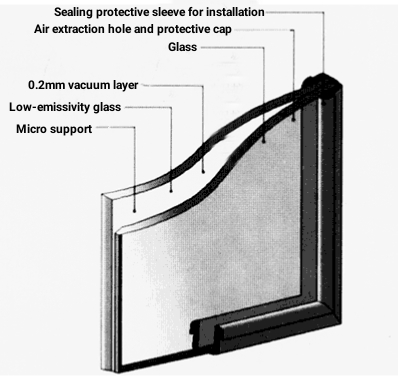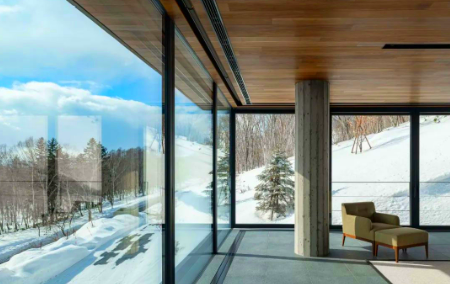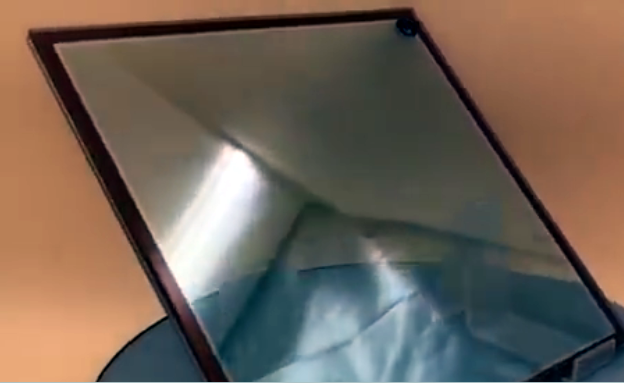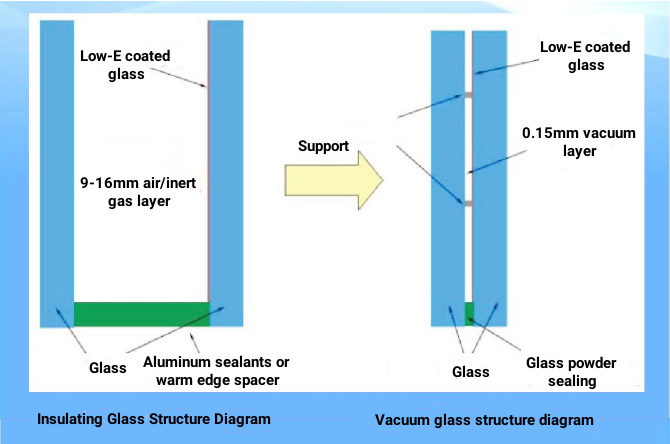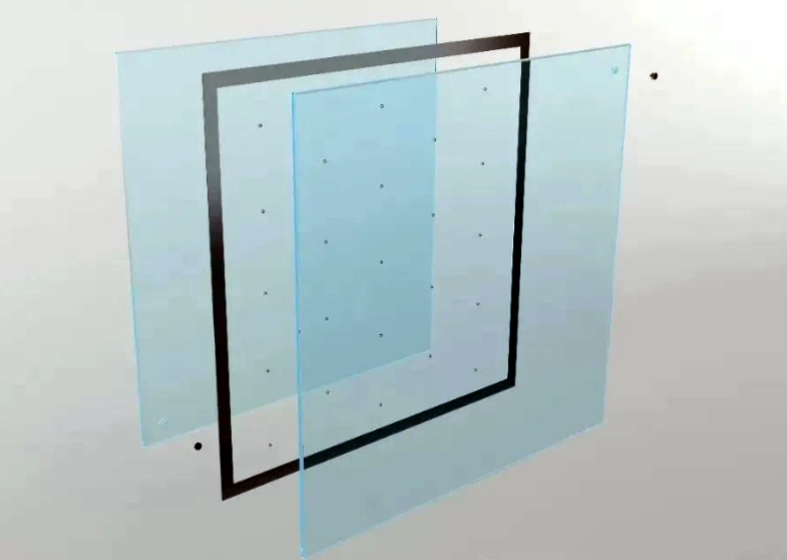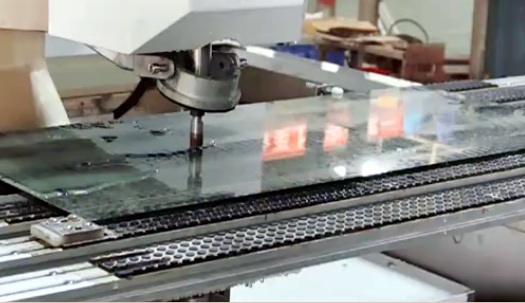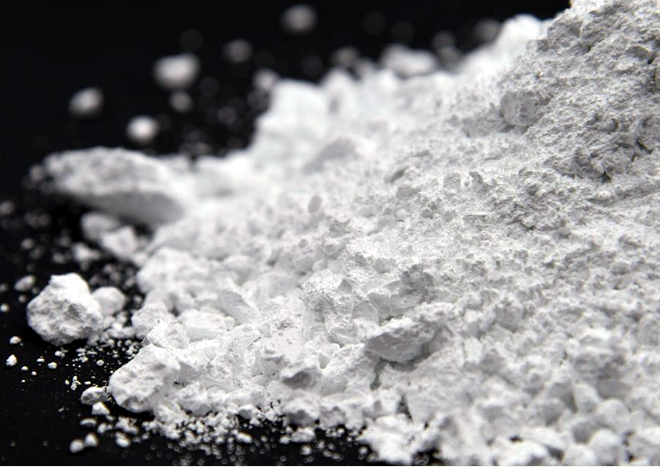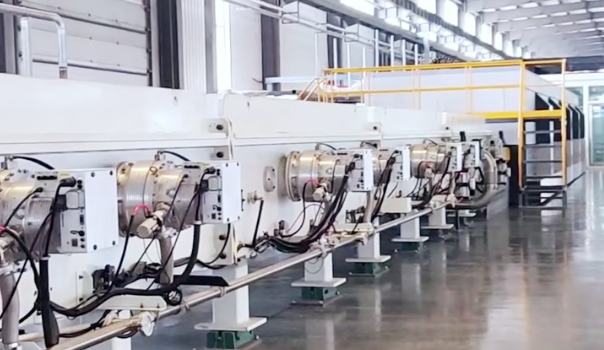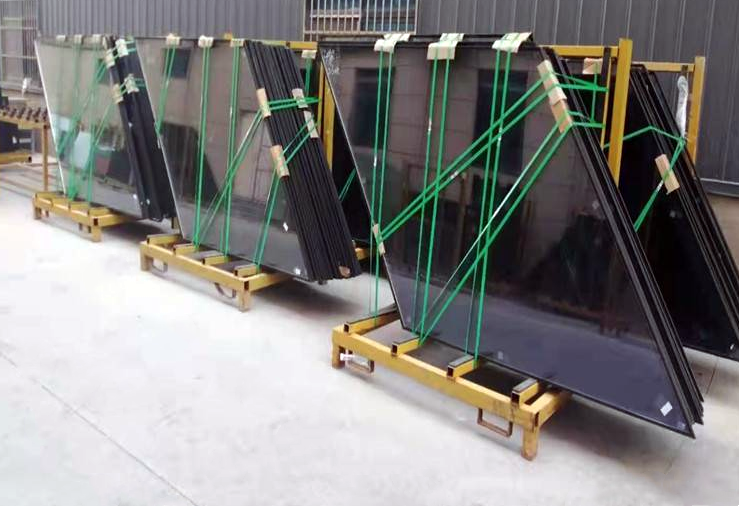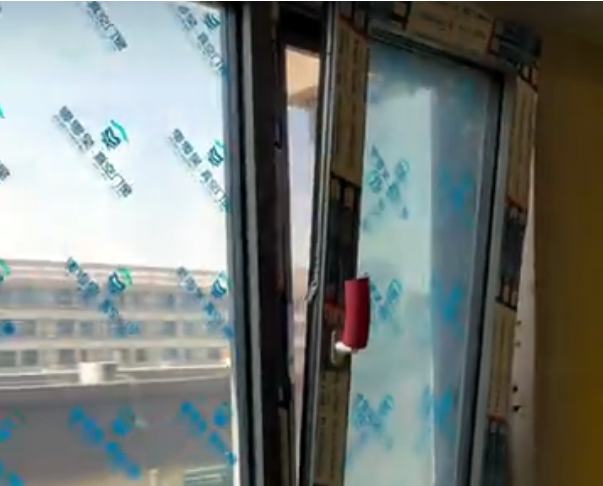Detailed explanation of the difference between vacuum glass and insulating glass.

1. Concept and principle of vacuum glass
Vacuum glass is a new type of glass deep processing product, and its production principle is based on vacuum insulation technology. Ordinary vacuum glass consists of two pieces of flat glass, separated by supports, and sealed around the periphery using low-melting point glass solder or metal solder to form a vacuum cavity. This structure makes vacuum glass excellent at thermal insulation.
To further improve the performance and effect of vacuum glass thermal insulation, at least one piece of low-emissivity coated glass is usually used among the two glass substrates to reduce heat transfer. A special metal or non-metal composite film can be applied between the glass on both sides of the cavity using a rare suspension film process to further enhance the thermal insulation performance of the vacuum glass and improve the stability of its overall structure.
Figure 1 The performance and effect of vacuum glass thermal insulation
When sunlight shines on the vacuum glass, the film will reflect most of the sunlight, and the vacuum state in the cavity effectively blocks heat conduction and convection, keeping the indoor temperature relatively stable. At the same time, under the joint action of the film layer and the vacuum cavity, the vacuum glass also has a sound insulation effect and can effectively block external noise.
Due to its excellent thermal insulation and thermal insulation properties, vacuum glass is widely used in construction, automobiles, ships, and other fields. Vacuum glass uses its special structure and materials to achieve multiple functions such as efficient thermal insulation, heat insulation, and sound insulation, providing a more comfortable and energy-saving environment for people's lives and work.
Figure 2 The vacuum glass is used in construction
2. The structural difference between vacuum glass and insulating glass
2.1 Types of glass substrates
- Vacuum Glass
Usually consists of two pieces of flat glass with a very thin vacuum chamber sandwiched between them. One piece of glass is often made of Low-E glass, which minimizes heat conduction, convection, and radiation through vacuum glass. In addition, to ensure the sealing and stability between glasses, the glass substrate of vacuum glass usually requires special treatment and processing.
Figure 3 The vacuum glass
- Insulated Glass
It consists of two or more pieces of glass with a certain space in between, and the space is filled with dry air or other gases. The glass substrate can be any type of glass such as tempered glass, laminated glass, coated glass, etc.
Figure 4 The insulating glass
2.2 Gas spacer layer
- Vacuum Glass
In the near vacuum state, the gap distance is 0.1~0.2mm, and the structure of only one nanopore layer also makes the vacuum glass lightweight and not easy to deform.
Figure 5 The glass structure between insulating glass and vacuum glass
- Insulated Glass
The middle is usually dry air or inert gas, and the gap distance is generally 6~12mm.
3. Performance comparison between vacuum glass and insulating glass
3.1 Vacuum glass has very high thermal insulation and thermal insulation properties
The thermal insulation and thermal insulation properties of vacuum glass are significantly better than insulating glass. Because its heat transfer coefficient is extremely low, generally around 0.8~1.5W/m2·K, which is much lower than the heat transfer coefficient of insulating glass (2.2~3.0W/m2·K). This means that under the same conditions, vacuum glass can better prevent heat transfer and keep the indoor temperature stable. Even when the outdoor temperature reaches minus 20°C, the inner surface temperature of vacuum glass is only 3~5°C lower than the indoor air temperature, showing its excellent thermal insulation performance. In comparison, the thermal insulation performance of ordinary glass is only 1/8 that of vacuum glass, while the thermal insulation performance of insulating glass is 1/3~1/5 that of vacuum glass.
| Glass type | Heat transfer coefficient K value W/(m2*K) | ||
| The angle between the glass and the horizontal | 90° | 45° | 0° |
| Vacuum glass | 0.48 | 0.48 | 0.48 |
| Insulated glass | 0.75 | 0.91 | 1.15 |
3.2 Vacuum glass has strong sound insulation performance
The sound insulation effect of vacuum glass is about 3 to 5 times that of insulating glass. Taking high-frequency sound of 2400Hz as an example, the sound insulation of vacuum glass can reach 34 dB, while the sound insulation of insulating glass is generally around 25 dB. Under the same environment, vacuum glass can better isolate the transmission of sound.
Figure 6 The vacuum glass has strong sound insulation performance
3.3 Vacuum glass has high wind pressure resistance
Vacuum glass exhibits high wind pressure resistance. When the thickness is 4mm, its wind pressure resistance is more than 1.5 times that of insulating glass of the same thickness. This means that under extreme wind conditions, such as level 10 winds and wind speeds of 25 seconds/m vacuum glass can still maintain its integrity and withstand wind pressure.
3.4 Impact resistance
The impact resistance of insulating glass is relatively good. The internal air can play a certain buffering role and reduce the impact of external impact on the glass.
Vacuum glass has poor impact resistance. Due to its internal vacuum state, it is not easy to disperse and absorb the impact when it is impacted by the outside and is easily broken. Therefore, the impact resistance is not as good as that of insulating glass, or even several times worse. This problem can be solved by adding tempered glass to one or both sides of the vacuum glass to form a laminated vacuum glass structure.
To sum up, vacuum glass has significant advantages in heat insulation, heat preservation, sound insulation, etc., but its wind pressure resistance and impact resistance are weak. Insulated glass has a relatively low cost and good performance, especially in terms of impact resistance, but its thermal insulation, thermal insulation, and sound insulation properties are not as good as vacuum glass.
4. Vacuum glass processing steps
The processing steps of vacuum glass are different from those of insulating glass and mainly include the following steps.
- Glass material selection and processing
Select the glass material suitable for making vacuum glass as needed, such as borosilicate glass or sodium borosilicate glass, and process the glass material into the shape of a sandwich between two pieces of glass, usually rectangular or circular.
- Glass washing and spraying
Wash the processed glass to remove dust and dirt on the surface. A washed Low-E film is then spray-coated on a piece of glass, one of the key steps in making vacuum glass.
Figure 7 The glass washing and spraying
- Place supports
On a piece of glass plate, according to the thickness and mechanical parameters of the glass plate, place cylindrical supports or linear or grid-like supports with smaller heights and diameters at certain intervals (between 20mm~40mm), and then place another glass plate.
Figure 8 The "supports" must be set up between the two layers of glass
Different from the production of ordinary insulating glass, the processing of vacuum glass requires this step because the research and development of vacuum glass is based on the principle of thermos flasks, but the application object has changed from a cylindrical or spherical thermos flask with balanced pressure resistance to a flat plate. During production, a matrix of "supports" must be set up between the two layers of glass to withstand the atmospheric pressure of about 10 tons per square meter, so that the distance between the glasses is maintained to form a vacuum layer.
- Install exhaust vent
Not all vacuum glass has an exhaust port. Vacuum glass with an exhaust port needs to install an exhaust hole on a glass plate, which can be drilled.
Figure 9 The glass hole punching processing
- Sealing
After the exhaust hole is installed, a protective cap needs to be installed to prevent it from being contaminated or damaged by the outside world. Finally, the surrounding edges are sealed, and special sealing materials, such as special glue for vacuum glass, are applied around the two glass plates to form a whole to ensure the integrity and sealing of the vacuum layer. As for whether further treatment of the vent is required after sealing, it depends on the specific product requirements and production process.
Figure 10 The glass powder
Different from the sealant materials used in ordinary insulating glass, the vacuum layer of vacuum glass requires it to withstand external atmospheric pressure, which requires extremely high sealing and stability. Therefore, glass powder or other metal materials and special sealants for vacuum glass are needed. Perform edge sealing.
- Vacuum
The presence or absence of the exhaust port will affect the way the vacuum glass is evacuated.
For vacuum glass with an exhaust port, vacuum equipment is used to evacuate the cavity enclosed between the glasses through the exhaust port, so that the vacuum pressure in the chamber between the glasses reaches a certain value to form a vacuum layer. After the exhaustion is completed, Install a protective cap or other sealing material to close the exhaust port.
Vacuum glass without exhaust vents uses a specific sealing structure and process to extract the air between the glass plates to form a vacuum environment.
Figure 11 The integrated vacuum exhaust equipment
- Heat treatment
Vacuum glass is heated at the appropriate temperature to enhance the adhesion and durability of the sealing layer and ensure the removal of moisture and organic matter from the glass panel.
- Cooling and inspection
After the vacuum glass is cooled, quality inspection of the vacuum degree, appearance, performance, and other aspects will be carried out. After passing the quality inspection, it can be packaged and shipped out of the factory.
5. Vacuum glass appearance quality inspection standards
5.1 Glass surface
For scratches with a length of less than 100mm and a width of less than 1mm, 8 scratches are allowed per square meter.
For scratches with a length greater than 100mm and a width between 0.1mm and 1mm, 4 scratches are allowed per square meter.
Cracks: Cracks are not allowed.
5.2 Vacuum chamber
The interior must be kept clean and free of any stains or impurities.
5.3 Edge sealing and edges
The width of the edge sealing should be greater than or equal to 5mm and should be even and straight.
There should be no cracks or other visible defects on the edges.
Each piece of glass is allowed to have an edge of no more than 10 mm in length per meter, no more than 2 mm extending from the edge of the glass to the surface of the glass plate, and no more than 1.5 mm extending from the surface of the glass to the thickness of the glass.
5.4 Support
They should be equally spaced and evenly spaced, with no overlap or missing parts.For discontinuous absences or excesses, there should not be more than 3 per square meter. For offsets exceeding 1/3 of the design spacing, there should not be more than 5 per square meter.
6. Precautions related to vacuum glass
6.1 Transportation and placement
Protective gloves, goggles, and foot protection shoes should be worn to ensure safety. It should be placed upright with its long side parallel to the ground; the part of the ground support that is in contact with the glass should not be made of hard material.
Figure 12 The transportation and placement of vacuum glass
6.2 Installation and use
When installed, the exhaust vent and protective cap should face the inside of the room, and be sure to be located at the upper corner of the window.
Excessive pressure or impact on the glass should be avoided during installation.
Figure 13 The installation and use of vacuum glass
When in use, the sealed part of the glass must not be exposed to avoid being hit or scratched.
The protective cap should be properly kept and extrusion, collision, and manual disassembly are strictly prohibited.
6.3 Maintenance and cleaning
Glass should be checked regularly for cracks or damage during use.When cleaning, use appropriate detergent and soft cloth, and avoid using detergents containing acid and alkali substances.
6.4 Long term storage
If not used for a long time, the vacuum glass should be stored in a dry, ventilated place and protected from direct sunlight. Also, ensure that the temperature and humidity at the storage location remain stable.
For more information about insulating glass processing equipment and glass processing machinery, please click here to learn more.
